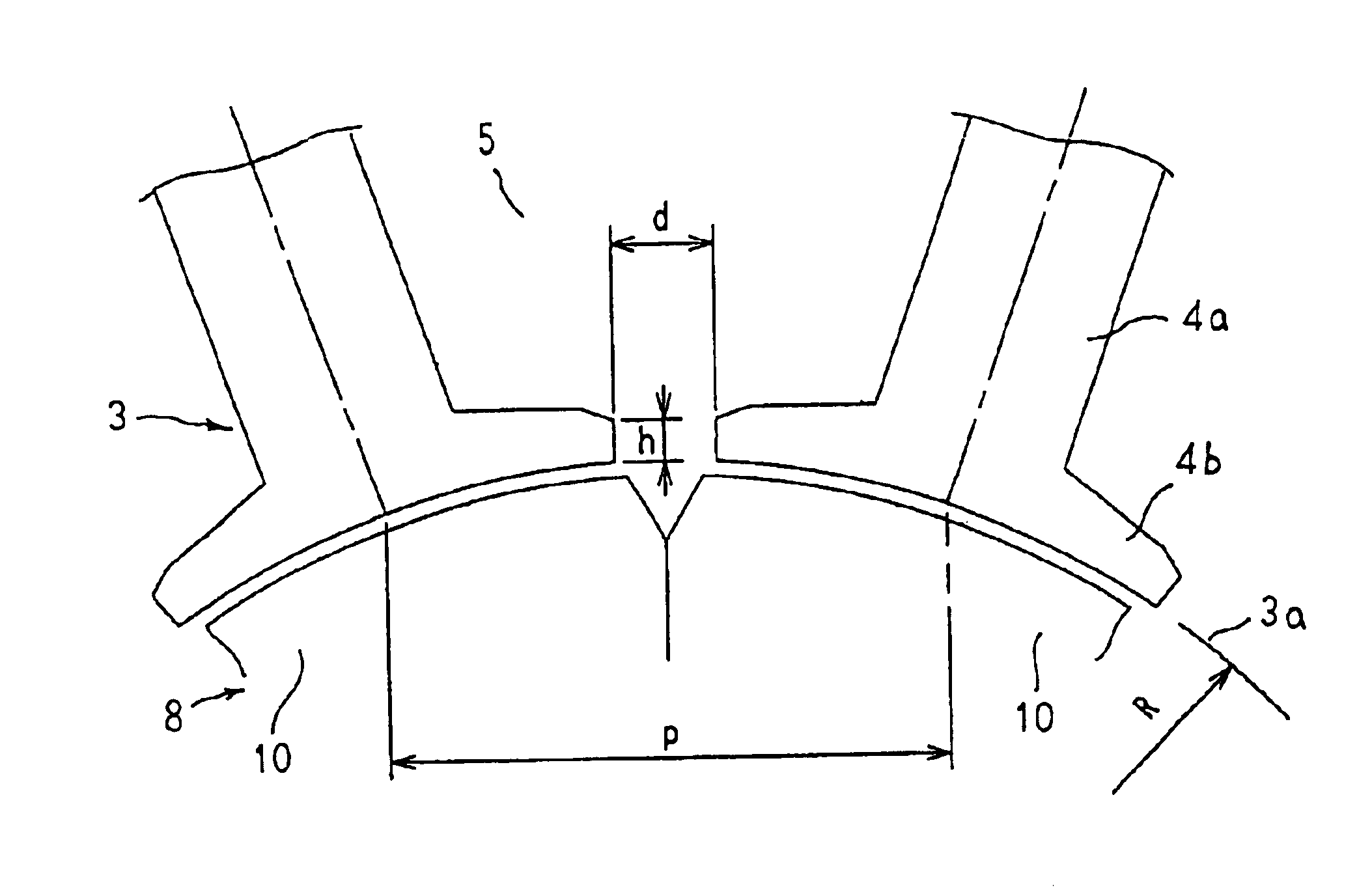Permanent magnet synchronous motor
- Summary
- Abstract
- Description
- Claims
- Application Information
AI Technical Summary
Benefits of technology
Problems solved by technology
Method used
Image
Examples
embodiment 1
[0026]FIG. 1 is a cross section showing a permanent-magnet synchronous motor according to Embodiment 1 of the present invention, and FIG. 2 is an enlarged cross section showing part of the permanent-magnet synchronous motor according to Embodiment 1 of the present invention.
[0027]In the figures, a concentrated-winding permanent-magnet synchronous motor 1 is constituted by: a stator 2; and a rotor 8 rotatably disposed inside the stator 2.
[0028]The stator 2 is constituted by: a cylindrical stator core 3 having core portions 4 corresponding in number to a number of slots 5; and a stator coil 6 installed in the stator core 3.
[0029]Each of the core portions 4 is constructed by laminating and integrating a predetermined number of sheets of a magnetic material such as a silicon steel sheet, for example. Teeth 4a formed on the core portions 4 are arranged at a uniform angular pitch in a circumferential direction, the slots 5 of the stator core 3 being formed between adjacent pairs of the te...
embodiment 2
[0042]In Embodiment 2, dimensions of the concentrated-winding permanent-magnet synchronous motor 1 according to Embodiment 1 above are set such that 0.2≦h / d≦0.7, where d is a slot opening of the stator core 3 and h is a thickness of an end portion of the flange portions 4b.
[0043]Now, results are shown in FIGS. 6, 7, and 8 in which the torque ratio (percent), the rotational frequency ratio (percent), and the inductance ratio (percent) were measured in a stator core 3 in which the slot pitch p at the inner circumferential surfaces 3a of the stator core 3 was 16.5 mm and the slot opening d was 3.0 mm (d / p=0.182), while h was varied.
[0044]From FIG. 6, it can be seen that when h / d is less than 0.2 (h / d<0.2), the torque ratio increases rapidly as h / d increases, and when h / d exceeds 0.2, the increase in the torque ratio is small. When h / d is equal to or greater than 0.2 (0.2≦h / d), the torque ratio is kept to a high level.
[0045]Thus, because changes in the characteristics of the motor due ...
embodiment 3
[0051]In Embodiment 3, the concentrated-winding permanent-magnet synchronous motor 1 according to Embodiment 1 above is constructed such that the relationship between the slot opening (d) and the slot pitch (p) and the relationship between the slot opening (d) and the thickness (h) of the end portion of the flange portions 4b in the stator core 3 satisfy the expression 0.1≦d / p≦0.3 and the expression 0.2≦h / d≦0.7, respectively.
[0052]Consequently, according to Embodiment 3, a synergistic combination of the effects of Embodiments 1 and 2 above can be achieved.
[0053]Moreover, each of the above embodiments has been explained with reference to a concentrated-winding permanent-magnet synchronous motor in which the number of magnetic poles in the rotor 8 is six and the number of slots is nine, but it is only necessary for the present invention to be applied to a 3-slot-per-2-pole concentrated-winding permanent-magnet synchronous motor, and for example, similar effects can also be achieved if...
PUM
 Login to View More
Login to View More Abstract
Description
Claims
Application Information
 Login to View More
Login to View More - R&D
- Intellectual Property
- Life Sciences
- Materials
- Tech Scout
- Unparalleled Data Quality
- Higher Quality Content
- 60% Fewer Hallucinations
Browse by: Latest US Patents, China's latest patents, Technical Efficacy Thesaurus, Application Domain, Technology Topic, Popular Technical Reports.
© 2025 PatSnap. All rights reserved.Legal|Privacy policy|Modern Slavery Act Transparency Statement|Sitemap|About US| Contact US: help@patsnap.com



